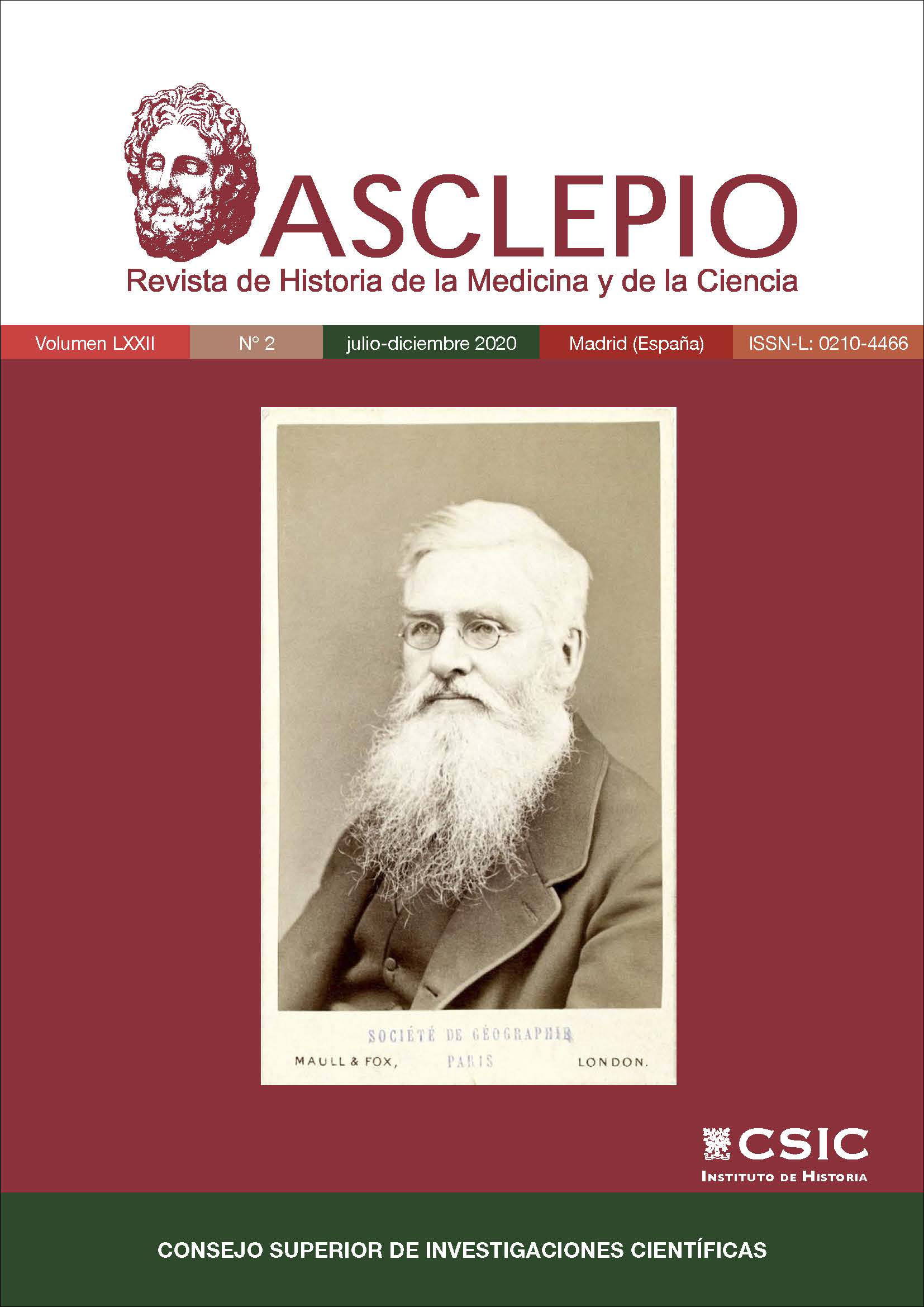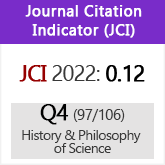Hacia una historia revisada de la teoría organizacional-activacional
DOI:
https://doi.org/10.3989/asclepio.2020.22Palabras clave:
organizacional-activacional, filosofía, neuroendocrinología, conductaResumen
En las últimas décadas la neuroendocrinología del comportamiento ha pasado de un área marginal de la incipiente revolución neurocientífica a una disciplina bien consolidada, hasta el punto de convertirse en el abordaje estándar para las diferencias y la diferenciación sexual de la conducta. Tanto en los trabajos de historia general de la endocrinología, como en las reviews de la especialidad y las aproximaciones críticas desde el feminismo académico, se ha generado un racconto según el cual la teoría central de la neuroendocrinología, esto es, la Teoría Organizacional Activacional habría sido fundada en 1959 por W. C. Young y sus colaboradores al descubrir los efectos de la testosterona fetal sobre conejillas de indias hembra. En el presente artículo se propone una revisión de tal historia oficial, comenzando con los trabajos de Arnold Berthold, profundizando en los desarrollos endocrinos de los años veinte y treinta del siglo pasado y revisando las disputas entre Young y Beach en los años previos a la publicación del 59. Con esta revisión, se pretende mejorar el conocimiento histórico de la teoría organizacional activacional, lo cual de forma derivada puede ayudar a iluminar algunas polémicas en torno a las explicaciones biológicas de la sexualidad humana.
Descargas
Citas
Aberle, Sophie Bledsoe; Corner, George Washington (1953), Twenty-five years of sex research: history of the National Research Council Committee for Research in Problems of Sex, 1922-1947, Philadelphia, Saunders.
Addison, Thomas (1849), On the Constitutional and Local Effects of Disease of the Suprarenal Capsules, London, Highley.
Alcoff, Linda; Potter Elizabeth, eds. (1993), Feminist Epistemologies, New York and London, Routledge
Anderson, Elizabeth (2020), "Feminist Epistemology and Philosophy of Science". En: Edward N. Zalta (ed.), The Stanford Encyclopedia of Philosophy, [en línea], disponible en: https:// plato.stanford.edu/entries/feminism-epistemology/, [consultado el 10/2/2020].
Aristóteles (ca. 347-335 BCE), Reproducción de los animales, Madrid, Gredos.
Arnold, Arthur. P. (2009), "The organizational-activational hypothesis as the foundation for a unified theory of sexual differentiation of all mammalian tissues", Hormones and Behavior, 55 (5), pp. 570-578. https://doi.org/10.1016/j.yhbeh.2009.03.011 PMid:19446073 PMCid:PMC3671905
Balthazart, Jacques (2011), "Minireview: Hormones and Human Sexual Orientation", Endocrinology 152, pp. 2937-2947. https://doi.org/10.1210/en.2011-0277 PMid:21693676 PMCid:PMC3138231
Balthazart Jacques (2016), "Sex differences in partner preferences in humans and animals", Philosophical Transactions of the Royal Society B: Biological Sciences, 371, pp. 20150118, [en línea]. https://doi.org/10.1098/rstb.2015.0118 PMid:26833838 PMCid:PMC4785903
Bayliss, William M.; Starling, Ernest. H. (1904), "The chemical regulation of the secretory process", Proceedings of the Royal Society of London, 73, pp. 310-322. https://doi.org/10.1098/rspl.1904.0045
Beach, Frank A.; Holz, Marie (1946), "Mating behavior in male rats castrated at various ages and injected with androgen", Journal of Experimental Zoology, 101, pp. 91-142. https://doi.org/10.1002/jez.1401010107 PMid:21016958
Beach, Frank A. (1945), "Hormonal induction of mating responses in a rat with congenital absence of gonadal tissue", Anatomical Record, 92, pp. 289-292. https://doi.org/10.1002/ar.1090920310
Beach, Frank A. (1969), "Locks and beagles", American Psychologist, 24, pp. 971-89. https://doi.org/10.1037/h0028876 PMid:5391950
Beach, Frank A. (1975), "Hormonal modification of sexually dimorphic behavior", Psychoneuroendocrinology, 1, pp. 3-23 https://doi.org/10.1016/0306-4530(75)90019-0
Beach, Frank A. (1976), "Sexual attractivity, proceptivity, and receptivity in female mammals", Hormones and Behavior, 7, pp.105-38. https://doi.org/10.1016/0018-506X(76)90008-8
Beach, Frank A. (1981) "Review: Historical origins of modern research on hormones and behavior", Hormones and Behavior, 15, pp. 325-376. https://doi.org/10.1016/0018-506X(81)90001-5
Bernabé, Federico N.. (2019), "Androcentrismo, ciencia y filosofía de la ciencia", Humanities Journal of Valparaíso, 0(14): 287-313. https://doi.org/10.22370/rhv2019iss14pp287-313
Bernabé, Federico N.; Giri, Leandro (2019), "It's a Male World: el sesgo sexual de los modelos animales en biología", Arbor,195(791), pp. a492, [en línea] disponible en: http://arbor revistas.csic.es/index.php/arbor/article/view/2307/3315, [consultado el 2/10/2020]. https://doi.org/10.3989/arbor.2019.791n1005
Berthold, Arnold A. (1944), "The Transplantation of testes" (traducción de Daniel P. Quiring), Bulleting of History of Medicine, 16, pp. 399-401. (Trabajo original publicado en 1849).
Blaschko, Hermann (1969), "Hormones and transmitters". En: Harré, Rom (ed.), Scientific Thought, 1900-60: A Selective Survey, Oxford, Clarendon Press, pp. 196-208.
Brookey, Robert A. (2002), Reinventing the Male Homosexual: The Rhetoric and Power of the Gay Gene, Bloomington, Indiana University Press.
Ciccia, Lucía (2017), La ficción de los sexos. Hacia un pensamiento Neuroqueer desde la epistemología feminista. Tesis doctoral disponible en el repositorio de la Facultad de Filosofía y Letras de la Universidad de Buenos Aires.
Dantchakoff, Vera (1938a), "Sur les effets de l'hormone mâle dans un jeune cobaye femelle traité depuis un stade embryonnaire(inversions sexuelles)", Comptes rendus des séances de la Société de biologie et de ses filiales Société de biologie, pp. 1255-1258.
Dantchakoff, Vera (1938b), "Sur les effets de l'hormone male dans un jeune cobaye male traité depuis un stade embryonnaire (production d'hypermales)", Comptes rendus des séances de la Société de biologie et de ses filiales Société de biologie, pp.1259-1262.
Dempsey, Edward. W.; Hertz, Rouy; Young, William C. (1936), "The experimental induction of oestrus (sexual receptivity) in the normal and ovariectomized guinea pig"; American Journal of Physiology,116, pp. 201-209. https://doi.org/10.1152/ajplegacy.1936.116.1.201
Dewsbery, Donald A. (1998), Frank Ambrose Beach 1911-1988, Washington D.C., National Academies Press.
Fausto-Sterling, Anna (1992), Myths of Gender, Nueva York, BasicBooks,
Fine, Cordelia (2008), "Will working mothers' brains explode? The popular new genre of neurosexismo", Neuroethics, 1(1), pp. 69-72. https://doi.org/10.1007/s12152-007-9004-2
Forbes, Thomas R. (1949), "A. A. Berthold and the First endocrine experiment: some speculation as to its origin", Bulleting of History of Medicine, 23, pp. 263-267.
Goy, Robert W. (1967), "William Caldwell Young", Anatomical Records, 157, pp. 3-11. https://doi.org/10.1002/ar.1091570103 PMid:5340015
Goy, Robert. W.; McEwen, Bruce S. (1980), Sexual Differentiation of the Brain Based on a Work Session of the Neurosciences Research Program, Cambridge, Massachusetts, The Mit Press.
Hamilton, James B.; Gardner, William U. (1937), "Effects in female young born of pregnant rats injected with androgens", Proceedings of the Society for Experimental Biology and Medicine, 37, pp.570-575. https://doi.org/10.3181/00379727-37-9645P
Harding, Sandra (1986), The Science Question in Feminism. Ithaca: Cornell University Press.
Jordan-Young, Rebbeca (2010), Brain Storm. Cambridge, Massachusetts: Harvard University Press.
Jørgensen, Claus B. (1971), John Hunter, A.A. Berthold, and the Origins of Endocrinology, Odense, Odense University press.
Jost, Arnold. (1947), "Recherches sur la différenciation sexuelle de l'embryon de lapin. III. Rôle des gonades foetales dans la différenciation sexuelle somatique". Archives d'anatomie microscopique et de morphologie expérimentale, 36, pp. 271 -316.
Jost, Arnold. (1970), "Hormonal Factors in the Development of the Male Genital System". En: Rosemberg E. https://doi.org/10.1007/978-1-4615-9008-8_2
Paulsen C. (eds.), The Human Testis: Proceedings of the Workshop Conference held at Positano, Italy, April 23.25, 1970, New York, Plenum Press, pp. 11-18
Lillie, Frank R. (1917), "Sex-Determination and Sex-Differentiation in Mammals", Proceedings of the National Academy of Sciences of the United States of America, 3, pp. 464-470. https://doi.org/10.1073/pnas.3.7.464 PMid:16576241 PMCid:PMC1091289
Longino, Hellen E. (1997), "Feminismo y filosofía de la ciencia". En: Marta González García y Eulalia Pérez Sedeño (eds.), Ciencia, tecnología y sociedad, Barcelona, Ariel, pp. 71-83.
Longino, Hellen E.; Doell, Ruth (1983), "Body, Bias, and Behavior: A Comparative Analysis of Reasoning in Two Areas of Biological Science", Signs, 9(2), pp. 206-227. https://doi.org/10.1086/494044
Loriaux, Lynn D. (2016), A Biographical History of Endocrinology, Hoboken, NJ, Wiley Online Library. https://doi.org/10.1002/9781119205791
Maffia, Diana (2007), "Epistemología feminista: la subversión semiótica de las mujeres en la ciencia", Revista Venezolana de estudios de la mujer, 12(28), pp. 63-98.
Martins, Thales; Valle, José R. (1948), "Hormonal regulation of the micturition behavior of dogs", Journal of Comparative and Physiological Psychology, 41, pp.301-311. https://doi.org/10.1037/h0054530 PMid:18885690
McCarthy, Margaret M. (2011), "Sexual differentiation of brain and behavior". In: Fink, G., Pfaff, D. W., Levine, J. (eds.), Handbook of Neuroendocrinology, Dordretch, Elsevier. https://doi.org/10.1016/B978-0-12-375097-6.10017-4 PMid:22718105
McCarthy, Margaret M.; Arnold, Arthur P. (2011), "Reframing Sexual Differentiation of the Brain", Nature Neuroscience, 14 (6), pp. 677-683. https://doi.org/10.1038/nn.2834 PMid:21613996 PMCid:PMC3165173
McCarthy, Margaret M.; Arnold, Arthur P.; Ball, Gregory F.; Blaustein, Jeffrey D.; De Vries, Geert J. (2012), "Sex Differences in the Brain: The Not So Inconvenient Truth", The Journal of Neuroscience: The Official Journal of the Society for Neuroscience, 32(7), pp. 2241-2247. https://doi.org/10.1523/JNEUROSCI.5372-11.2012 PMid:22396398 PMCid:PMC3295598
Medvei, Victor C. (1982), A history of endocrinology, Lancaster, Falcon House. https://doi.org/10.1007/978-94-009-7304-6
Pfaff Donald W.,;Rubin Robert T.; Schneider, Jill E.; Head, Geoffrey A. (2018), Principles of Hormone/Behavior Relations (Second Edition), London, Academic Press. https://doi.org/10.1016/B978-0-12-802629-8.00007-3
Pfeiffer, Carroll A. (1935), "Origin of functional differences between male and female hypophyses". Proceedings of the Society for Experimental Biology and Medicine, 32, pp. 603-605. https://doi.org/10.3181/00379727-32-7781C
Pfeiffer, Carroll A. (1936), "Sexual differences of the hypophyses and their determination by the gonads", American Journal of Anatomy, 58, pp. 195-225. https://doi.org/10.1002/aja.1000580112
Phoenix, Charles H.; Goy, Robert W.; Gerall, Arnold A.; Young, William C. (1959), "Organizing action of prenatally administered testosterone propionate on the tissues mediating mating behavior in the female guinea pig", Endocrinology, 65, pp.369-382. https://doi.org/10.1210/endo-65-3-369 PMid:14432658
Potter, Elizabeth (2006), Femminism and Philosophy of Science, New York, Routledge.
Raynaud, A. (1938), "Comportement sexuel des souris femelles intersexuées", Comptes rendus des séances de la Sociétéde biologie et de ses filiales, 127, pp. 993-995.
Setchell, Brian P. (1984), "Male Reproduction" en Langley, Leroy L. (ed.) Benchmark Papers in Human Physiology, New York, Van Nostrand Reinhold, pp. 1-401.
Sodersten, Per; Crews, Drews; Logan, Cheryl; Soukup, Rudolf W. (2013), "Eugen Steinach: The First Neuroendocrinologist", Endocrinology, 155(3), pp. 688-702. https://doi.org/10.1210/en.2013-1816 PMid:24302628
van den Wijngaard, Marianne (1997), Reinventing the Sexes: The Biomedical Construction of Femininity and Masculinity, Bloomington, Indiana University Press.
Wallen, Kim (2009), "The Organizational Hypothesis: Reflections on the 50th anniversary of the publication of Phoenix, Goy, Gerall, and Young (1959)", Hormones and Behavior, 55(5), 561- 565. https://doi.org/10.1016/j.yhbeh.2009.03.009 PMid:19446072
White, Abraham; Levine, Rachmiel (1982), "History of Hormones". En: Goldberger Robert F.; Yamamoto Keith R. (eds.), Biological Regulation and Development, Boston, Springer. https://doi.org/10.1007/978-1-4684-1125-6_1
Wilson, James G.; Young, William C.; Hamilton, James B. (1940), "A technique suppressing development of reproductive function and sensitivity to estrogen in the female rat", Yale Journal of Biology and Medicine, 13, pp.189-202.
Young, William C.; Goy, Robert.; Phoenix Charles R. (1964), "Hormones and Sexual Behavior", Science,143 (3603), pp. 212-218. https://doi.org/10.1126/science.143.3603.212 PMid:14077548
Young, William C. (1929), "A study of the function of the epididymis II. The importance of an aging process in sperm for the length of the period during which fertilizing capacity is retained by sperm isolated in the epididymis of the guinea pig", Journal of Morphology and Physiology, 48, pp. 475-491. https://doi.org/10.1002/jmor.1050480208
Young, William C. (1929), "A study of the function of the epididymis. I. Is the attainment of full spermatozoon maturity attributable to some specific action of the epididymal secretion?", Journal of Morphology and Physiology, 48, pp. 479-495. https://doi.org/10.1002/jmor.1050470206
Young, William C. (1931), "A study of the function of the epididymis III. Functional changes undergone by spermatozoa during their passage through the epididymis and vas deferens in the guinea-pig", Journal of Experimental Biology, 8, pp. 151-162. https://doi.org/10.1242/jeb.8.2.151
Young, William C.; Simeone, Fiorindo A. (1930), "Development and fate of spermatozoa in the epididymis and vas deferens in the guinea pig", Proceedings of the Society for Experimental Biology and Medicine, 27, pp. 838-841. https://doi.org/10.3181/00379727-27-4997
Young, William C.; Dempsey, Eduard W; Myers, Hugh I (1935), "Cyclic reproductive behavior in the female guinea pig". Journal of Comparative Psychology. 19, pp- 313-335. https://doi.org/10.1037/h0060351
Young, William C.; Myers, Hugh I.; Dempsey, Eduard W. (1933), "Some data from a correlated anatomical, physiological and behavioristic study of the reproductive cycle in the female guinea pig", American Journal of Physiology, 105, pp. 393-398. https://doi.org/10.1152/ajplegacy.1933.105.2.393
Publicado
Cómo citar
Número
Sección
Licencia
Derechos de autor 2020 Consejo Superior de Investigaciones Científicas (CSIC)

Esta obra está bajo una licencia internacional Creative Commons Atribución 4.0.
© CSIC. Los originales publicados en las ediciones impresa y electrónica de esta Revista son propiedad del Consejo Superior de Investigaciones Científicas, siendo necesario citar la procedencia en cualquier reproducción parcial o total.Salvo indicación contraria, todos los contenidos de la edición electrónica se distribuyen bajo una licencia de uso y distribución “Creative Commons Reconocimiento 4.0 Internacional ” (CC BY 4.0). Puede consultar desde aquí la versión informativa y el texto legal de la licencia. Esta circunstancia ha de hacerse constar expresamente de esta forma cuando sea necesario.
No se autoriza el depósito en repositorios, páginas web personales o similares de cualquier otra versión distinta a la publicada por el editor.
Datos de los fondos
Universidad Nacional de Quilmes
Números de la subvención PUNQ 1401/15;UNTREF 32/15 225;PICT 2014- 1741















